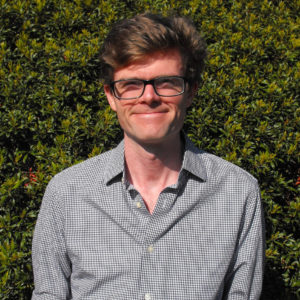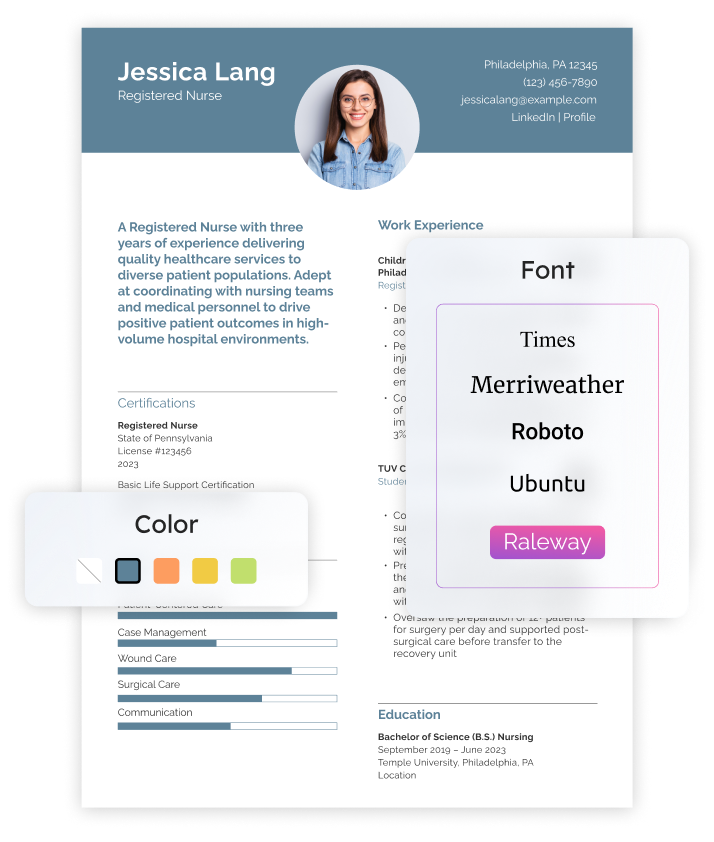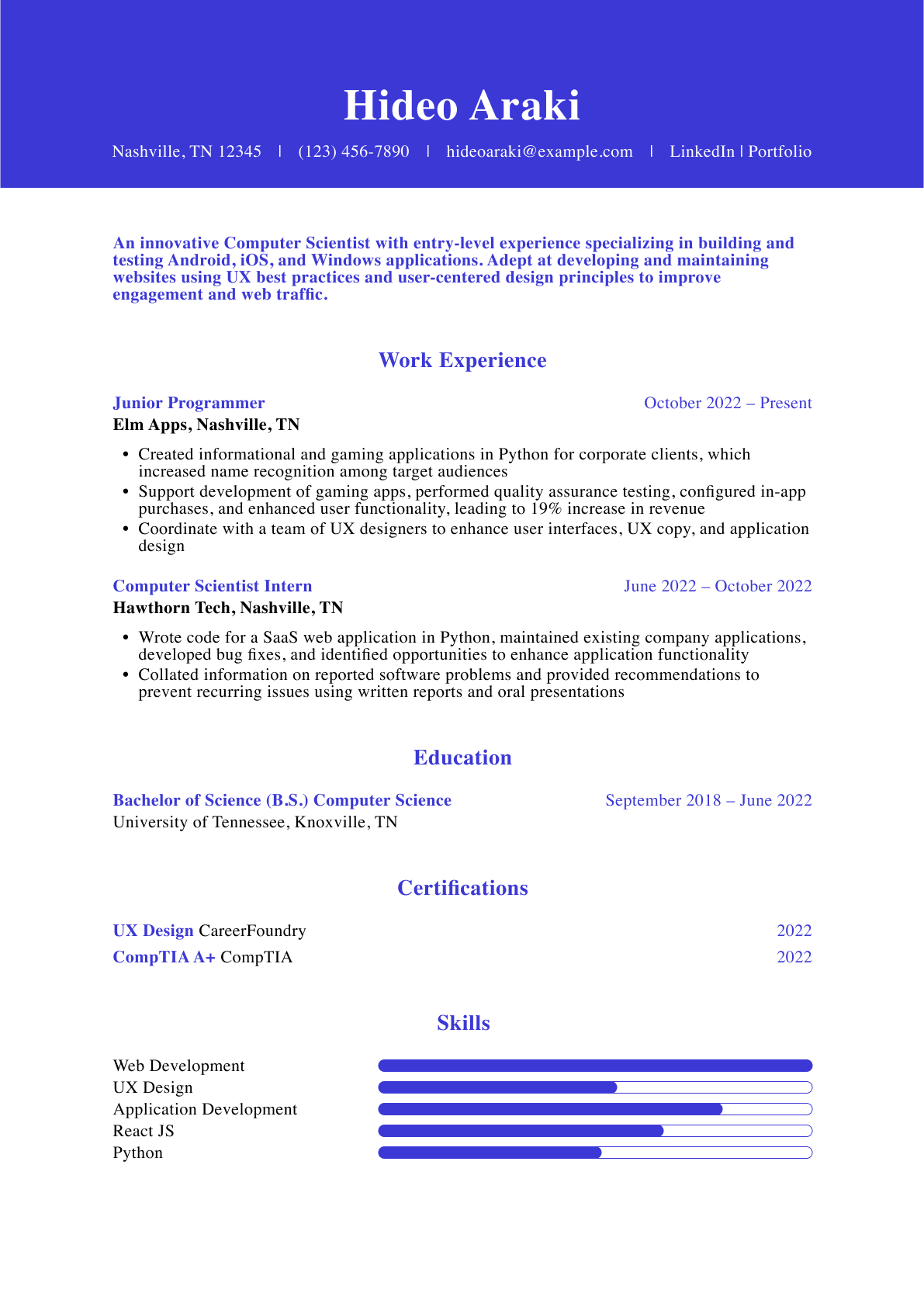If you’ve ever searched for a job and wondered whether to submit a curriculum vitae (CV) or a resume, you’re not alone. Many people may not even know what CV is short for or why it’s called a “resume.” In this guide, we’ll explore the purpose of each document, when to use one over the other, and what to include.
Documents for Different Markets
Origins of the curriculum vitae and resume
“CV” and “resume” are unique terms used to describe essential job application documents. Beyond being a fun trivia fact, understanding the definition of these words can help clarify the differences between the two.
Curriculum vitae is a Latin phrase meaning “course of one’s life,” while resume is a French word that translates as “to summarize.”

Tip!
Tip!
Curriculum vitae is a Latin phrase meaning “course of one’s life,” while resume is a French word that translates as “to summarize.”
The concept of these documents emerged in the Middle Ages when artisans would create a summarization of their life’s work and present it to potential employers. One such Renaissance artisan, Leonardo di Vinci, wrote a letter to the Duke of Milan, offering his services with a description of his skills and expertise as an artist. This laid the foundation for job search tools like CVs and resumes.
Regional differences in a resume vs. CV
In the U.S., resumes are the go-to document for most job applications, while CVs are reserved for academic, medical, and research-oriented roles. There’s a difference between these terms in the U.S. that shouldn’t be overlooked. According to career expert Robin Ryan, it’s common for people to misunderstand this difference when determining whether they need a CV vs. a resume.
While the terms CV and resume are often used interchangeably, they cater to different roles and regions. If you venture into the global market and apply for jobs internationally, it’s important to know the terms “CV” and “resume” can be interchangeable. What people in Europe and Asia call a CV often resembles a U.S. resume.
What is a resume?
A resume is a short (one- to three-page) document outlining your qualifications for a job. Tailor your work experience to align with the job description for maximum impact. Resumes are the usual hiring tool for companies and most nonprofits. If you’re looking for a job in either of these sectors, you’ll probably need a resume. We’ve provided a quick example below, but you can explore our library of resume template examples for more inspiration. Most employers prefer a resume that concisely presents your key qualifications. Resumes generally span one to two pages, making it essential to prioritize relevant information. An effective resume often begins with a professional summary tailored to the job. For inspiration, see our resume summary examples.
Business Intelligence Analyst Resume Example
Aisha Landry
(123) 456-7890
[email protected]
New York, NY 12345
Profile
A results-driven business intelligence analyst with five years of experience specializing in data analytics, business analysis, data visualization, and business modeling. A proven track record of managing complex analytic projects for multi-million-dollar businesses to enable data-driven decision-making and define long-term financial strategy.
Professional Experience
Business Intelligence Analyst, Manhattan Finance Firm, New York, NY
June 2018 – present
- Manage data analytics initiatives valued at up to $1.5 million, transform key performance indicators (KPIs) into business insights, and identify data trends to inform business decision-making for the organization
- Improve data visualization for senior leadership and finance teams, which includes developing a new dashboard to provide key insights on financial performance
- Identify opportunities to automate manual data entry processes for business results, reducing over 400 work hours per year
- Lead a team of business analysts and data stewards to execute ad hoc reporting projects, provide coaching, and support professional development
Business Intelligence Analyst, Brooklyn Investment Inc., New York, NY
May 2016 – June 2018
- Developed scalable business solutions to support operational needs, including the creation of business intelligence models and automated data reporting systems
- Performed statistical analysis on business data and created action plans based on findings to facilitate data-driven decision-making
Education
Bachelor of Business Administration (B.B.A.)
University of New York, New York, NY | May 2016
Key Skills
- Business modeling
- Business reporting
- Data analytics
- Data visualization
- Tableau
Certifications
- Microsoft Certified Data Analyst Associate, 2019
- Tableau Server Certified Professional, 2017
The primary goal of a resume is to provide a snapshot of your professional background, skills, accomplishments, and qualifications. The information you include in a resume must be tailored specifically for the position you’re applying for. In a competitive market, it must stand out by demonstrating how you’re the perfect fit for the job.
Here are the three main characteristics of a resume:
- Brevity: A resume should be concise and targeted, focusing on your most relevant professional information. It should emphasize career achievements and skills that directly align with the job description.
- Customization: While your resume is all about you, make it easily customizable to cater to different employers. Most modern templates are created with this in mind so job seekers can optimize their resume whenever and wherever they need.
- Structure: Resumes include designated sections highlighting things such as work experience, skills, and education. Depending on your experience level and industry, this may also cover things like certifications, volunteer work, affiliations, and hobbies.
What is a curriculum vitae?
In the U.S., a CV is a lengthy job search document used by candidates in science and academia. It’s also common in other fields requiring particular education or credentials, such as aviation, medicine, and law. The CV vs. resume decision will depend heavily on your industry expectations and the role you’re applying for.
Check out this CV example:
Environmental Scientist CV Example
Sarah Thompson, Ph.D.
San Diego, CA 12345 | (123) 456-7890 | [email protected] | LinkedIn
Education
University of California, Berkeley
Doctor of Philosophy (Ph.D.) – Environmental Science | 2020
- Dissertation: “Impacts of Urban Development on Wetland Ecosystems: A Comparative Analysis of Restoration Techniques”
University of California, Berkeley
Master of Science (MS) – Environmental Science | 2016
- Thesis: “Assessing the Effects of Climate Change on Coastal Wetlands in the Pacific Northwest”
University of Oregon
Bachelor of Science (BS) – Environmental Science | 2014
- Select Coursework: Wetland Ecology, Environmental Data Analysis, Conservation Biology
- Honors: summa cum laude
Research Interests
- Urban Ecology and Wetland Restoration
- Impacts of Climate Change on Aquatic Ecosystems
- Sustainable Land Use Planning and Biodiversity Conservation
Research Experience
Postdoctoral Researcher, Center for Urban Environmental Research, San Diego, CA
2020 – present
- Led a multi-disciplinary research team of five researchers, examining the effectiveness of green infrastructure in urban wetland restoration
- Developed and implemented 12 field studies to assess biodiversity outcomes in restored wetland areas
- Published findings in four top-tier environmental journals, and presented results at five international conferences
Graduate Research Assistant, Department of Environmental Science, UC Berkeley, CA
2016 – 2020
- Conducted field research on the effects of urbanization on native wetland plant species and collected data across 15 sites
- Collaborated on a project funded by the EPA with a $150,000 grant to model climate change impacts on coastal wetland ecosystems
- Assisted in teaching six undergraduate courses and mentoring 10 students in research methods
Research Intern, Oregon Department of Environmental Quality, Portland, OR
2014 – 2016
- Analyzed water quality data from 20 wetland sites to support policy recommendations for wetland protection initiatives
- Participated in eight public outreach programs, educating over 500 local community members about environmental conservation practices
Board Memberships
Society for Wetland Scientists
Ecological Society of America
Urban Ecology Research Consortium
Publications
Author:
- “Restoring Urban Wetlands: Challenges and Opportunities,” Journal of Environmental Restoration, 2022 | link
- “Biodiversity Benefits of Green Infrastructure in Urban Settings,” Environmental Science & Technology, 2021 | link
- “Comparative Analysis of Wetland Restoration Techniques,” Wetlands Journal, 2020 | link
Co-Author:
- “Urbanization and Its Impact on Wetland Ecosystems,” Global Ecology and Biogeography, 2019
- “Modeling Climate Change Impacts on Pacific Northwest Wetlands,” Ecological Applications, 2018
Presentations and Seminars
“Innovative Approaches to Urban Wetland Restoration,” International Wetlands Conference, 2022
“The Role of Green Infrastructure in Urban Biodiversity,” Ecological Society of America Annual Meeting, 2021
“Wetland Restoration in Urban Landscapes: A Case Study,” Society for Wetland Scientists Symposium, 2020
“Climate Change and Wetlands: Future Challenges,” UC Berkeley Environmental Science Seminar Series, 2019
Grants
“Urban Wetland Restoration in the Pacific Northwest,” National Science Foundation | $250,000, 2021 – 2023
“Assessing the Biodiversity Impact of Green Infrastructure,” Environmental Protection Agency | $150,000, 2020 – 2022
“Modeling Climate Change Effects on Wetland Ecosystems,” UC Berkeley Research Fund | $50,000, 2019 – 2020
The purpose of a CV is to present an in-depth record of your expertise and qualifications, providing a complete portrait of your career and academic journey. Your contributions, dedication to ongoing education, and overall professional development take center stage to present you as a qualified and respected expert in your domain.
Let’s discuss the main qualities of a CV:
- Depth: In the U.S., a CV is an extensive overview of your academic and professional history, often spanning multiple pages. The average resume length is a little more than one page, but a CV isn’t limited to a certain length and often provides much more detail.
- Focus: A resume’s primary focus is your current and past work experience. A CV, however, dives deeper into your educational pursuits, research contributions, and publications. This is particularly important for jobs in academia.
- Evolution: CVs evolve over the years as you gain more experience and education. While a resume is fine tuned and well-tailored to specific positions, a CV acts as a living document to tell the ongoing story of your professional life.
When To Use a Resume vs. CV
Although resumes and CVs both focus on a candidate’s relevant background, they do so in different ways. They don’t each make the same impression on the recruiter or hiring manager. While the resume uses a hard-hitting profile summary of your top selling points, the CV takes a subtler approach, often omitting the profile and letting your credentials speak for themselves.
So, how do you know which one to use for your job search? It’s vital to understand when to use a CV vs. a resume and ensure your application aligns with employer expectations. Let’s explore the best uses for each document.
Resume: best for most job applications
If you’re applying for a position in business, technology, marketing, finance, and any other industry outside of academia and research, a resume will be your go-to document. It’s designed to quickly convey your most relevant skills, experiences, and accomplishments in the field. Making a strong first impression in a fast-paced hiring market is the goal for jobs within:
- Business
- Customer service
- Design
- Finance
- Marketing
- Operations
- Sales
- Technology
Curriculum vitae: essential for academic, medical, and research positions
In the U.S., you’ll need a CV for fields that have specific educational and professional requirements. Your CV should provide an exhaustive account of things like your academic background, research, teaching experience, and professional affiliations. Positions that often require a CV instead of a resume include:
- Clinical researcher
- Laboratory director
- Legal scholar
- Medical doctor
- Policy analyst
- Professor
- Psychologist
- Scientific consultant
What To Include in a Resume
The following sections make up the foundation of any well-rounded resume or CV for that matter. Most employers expect resumes to include key sections like work experience, education, and certifications. Work experience remains a central section, showcasing your achievements and growth over the years. Once we’ve covered what to include in a resume, we’ll explore additional sections commonly found in a CV. Understanding these differences will help you make the right choice when deciding on a resume vs. CV for your job application. Most employers focus on skills and achievements aligned with the role, ensuring a quick assessment.
The main components of a resume include:
1. Your name and contact information
2. Profile summary of your key strengths
3. Recent professional, volunteer, and internship experience
4. Key skills, languages, and areas of expertise
5. Education and certifications
1. Your name and contact information
Your contact information should be displayed prominently at the top of your resume. Include your full name, phone number, an email address, and the URL for your LinkedIn profile. Ensure these details are up-to-date and professional so potential employers can reach you to set up an interview or ask you further questions.
2. Profile summary of your key strengths
The first paragraph of a resume should briefly summarize your professional brand and answer who you are, what you’re known for, and what makes you most qualified for the job. If you’re early in your career, consider using an objective statement instead of a profile, focusing on how your goals and strengths align with the company’s needs.
3. Recent professional, volunteer, and internship experience
Most resumes are centered around a professional experience section that lists your employment history in reverse chronological order. Each job is described using bullet points to outline past responsibilities and achievements. If you have volunteer, internship, or another type of experience, you can create a separate but similar section for those positions.
4. Key skills, languages and areas of expertise
If you’d like to list core technical skills and interpersonal abilities, your resume should feature a key skills list. This curated collection of bullet points makes it easy for hiring managers to capture your top qualifications. The best skills lists are aligned with the job description to demonstrate that you meet the job’s skill requirements.
5. Education and certifications
Resumes often have a very simple education section listing your most recent degree, the school’s name, and your graduation date. For entry-level professionals and recent graduates, you can include extra details like your GPA (if it’s 3.5 or higher), honors, and relevant coursework. If you have special certifications related to the job, create a separate section to feature those as well.
Resume Template Example
Your Name
(123) 456-7890
[email protected]
City, State Zipcode
Profile
[Brief professional summary]
Professional Experience
Job Title, Company Name, City, State
Start Month Year – present
- [Achievement]
- [Achievement]
- [Achievement]
Job Title, Company Name, City, State
Start Month Year – End Month Year
- [Achievement]
- [Achievement]
- [Achievement]
Education
Degree Name — Concentration | Graduation Month Year
School Name, City, State
Key Skills
- [Skill]
- [Skill]
- [Skill]
Certifications
- Certification Name or Title, Awarding Organization, Year
What To Include in a Curriculum Vitae
Beyond the basic resume elements mentioned above, you can expect to add on a few more specialized sections for a CV. Depending on your field, this could be scientific research, awards, grants, lecturing experience, and professional affiliations. These additional sections define the major differences in the CV vs. resume debate. Academic positions often require a CV highlighting your research, teaching, and publications.
Let’s look at the unique information covered in a CV:
1. Research
2. Publications and presentations
3. Grants, fellowships, scholarships, and awards
4. Professional memberships
5. Internships and other relevant experience
1. Research
Research is often a core component for professionals in academia. Related sections provide a detailed overview of your research endeavors, including positions, academic projects, methodologies, and contributions. This information can be set up like the professional experience section of a resume, with a focus on the outcomes and findings of your research. For academic positions, it’s important to balance detailed research accomplishments with relevant work experience.
2. Publications and presentations
If you’ve been published as an author or co-author in books, journals, conference proceedings, or online publications, create chronological citations for each contribution. Likewise, you can create a section to highlight public speaking engagements such as keynote presentations, seminars, and workshops to establish your credibility as a subject matter expert.
3. Grants, fellowships, scholarships, and awards
A CV is the perfect place to list your success in securing funding and recognition within your field. Your ability to attract resources and awards is highly valued in academic and research settings that depend on external support.
Feature prestigious fellowships and scholarships that support your career, and list awards or honors recognizing your excellence in research or teaching. Provide details on any grants you’ve earned starting with the grant title, funding organization, amount, timeframe, and purpose or project funded.
4. Professional memberships
To demonstrate engagement with your field, include your involvement with professional organizations like academic societies and industry groups. Listing these on your CV shows a willingness to contribute to the professional community in service to committees or boards. Stick with memberships directly related to your field or area of expertise and highlight leadership roles.
5. Internships and other relevant experience
Other relevant experiences such as internships or volunteer work are all valuable additions to your CV. These activities demonstrate practical and technical skills that may not be covered in other sections. Include experiences that complement your academic background and have helped you develop relevant skills and hands-on experience.
Curriculum Vitae Template Example
Your Name
City, State Zipcode | (123) 456-7890 | [email protected] | LinkedIn
Education
School Name, City, State
Degree Name | Graduation Month Year
Dissertation: “Title”
Honors: designation
Select Coursework: Course Name | Course Name | Course Name
School Name, City, State
Degree Name | Graduation Month Year
Thesis: “Title”
Honors: designation
Select Coursework: Course Name | Course Name | Course Name
Research Interests
[Relevant area of research]
[Relevant area of research]
[Relevant area of research]
Research Experience
Position Title, Organization Name, City, State | Start Month Year — present
- [Work duty or highlight]
- [Work duty or highlight]
- [Work duty or highlight]
Position Title, Organization Name, City, State | Start Month Year — End Month Year
- [Work duty or highlight]
- [Work duty or highlight]
- [Work duty or highlight]
Board Memberships
Organization Name
Organization Name
Organization Name
Publications
Author:
- “Article Title,” Publication Name, date | hyperlink
- “Book Chapter Title,” Publication Name, date | hyperlink
Co-Author:
- “Article Title,” Publication Name, date
- “Article Title,” Publication Name, date
Presentations and Seminars
“Presentation Title,” Event Name, date
“Presentation Title,” Event Name, date
“Seminar Title,” Event Name, date
“Seminar Title,” Event Name, date
Grants
“Title,” Funding Organization | $ amount, time span
“Title,” Funding Organization | $ amount, time span
“Title,” Funding Organization | $ amount, time span
Choosing the Right Document for Your Job Search
Knowing when to use a CV vs. a resume is key to crafting the perfect job application. Understanding the role of a CV and a resume can significantly improve your chances in the job market. Whether you’re applying for a corporate role in the U.S., a creative position abroad, or a medical residency program, using the right document will help you make a strong impression on employers. If applying for academic positions, include comprehensive details on education and research.
Now that you understand the difference between a resume and a CV, you can decide which document to use for your job search. For more CV and resume inspiration, visit our examples library for a collection of templates spanning industries and experience levels. A resume typically spans one to two pages, depending on the job market and experience level.
Frequently Asked Questions: Curriculum Vitae vs. Resume
What details should I leave off my curriculum vitae?-
Any that don’t pertain to the job you’re seeking. Despite their length, CVs follow the same core principle as a resume: Focus on relevant information. Remember this rule, and you can make the right decisions on organizing each CV section, no matter the scope of your career details.
For example, say you’ve authored or co-authored 25 research articles. If they all align with your current research interests, you can confidently list them all in your CV’s publications section. But if you’re making a career change and only 10 of the articles align with your current interests, include just those 10 and name the section “Select Publications.” And if none align, you may opt not to have a publications section at all.
How far back should you go on your curriculum vitae?+
Above all else, your CV should only include the most relevant experiences, achievements, and qualifications for the position in question. Typically you’ll be focusing on the last 10 to 15 years of your career and education. However, if you have older experiences that are key to your background or early career internships and positions, include them if it makes sense. Ensure your document is concise — typically one or two pages, depending on the role.
Does a curriculum vitae include a cover letter?+
No. Keep and submit your cover letter as a separate document unless the job posting instructs otherwise.
Do I need a curriculum vitae for international jobs?+
Yes and no. The term “CV” is basically just another word for “resume” in many regions outside the U.S. So, if an international job posting asks for a CV, you may just need to change the name of the file you upload from “[Your Name] – Resume” to “[Your Name] – CV.” But different regions follow varying CV standards.
For instance, in some Asian countries, it’s customary to include personal details like your date of birth or marital status. Always research to make sure your application fits the international job market you’re targeting when determining whether to use a CV vs. a resume.
Craft your perfect resume in minutes
Get 2x more interviews with Resume Builder. Access Pro Plan features for a limited time!




